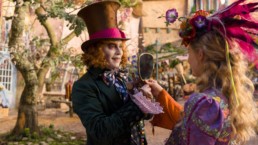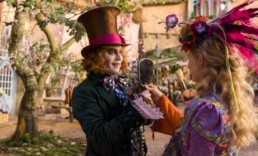Lighter in Tone, ‘Alice Through the Looking Glass’ is More Disheveled Than Its Predecessor
This is a custom heading element.
“Alice in Wonderland” is one of the world’s great “modern” fairy tales. Okay, well, Lewis Carroll’s original novel is nearly 150 years old, so to call it modern would be hardly accurate. But looking at this decade’s affinity for modernizing the classic fables of lore and dressing them up with lots of CGI, dashing them with a cup of angst and coating them in 3D to boost those box office numbers, no movie is more greatly responsible than Tim Burton’s 2010 blockbuster adaptation of “Alice In Wonderland.” Six years and nearly a dozen remakes later, “Alice Through the Looking Glass” falls into theaters.
“Alice Through The Looking Glass” is perhaps a misleading title as the story only begins with Alice (Mia Wasikowska) finding her back to Wonderland through a mirror at a luxurious party. Once there, she finds the Mad Hatter (Johnny Depp) literally withering away in defeat from his family’s disappearance many years ago. After finding a paper hat that he thought his father tossed away, he is convinced they are still alive, and thus, Alice sets out to change history by meeting Time (Sacha Baron Cohen) and see if she can keep the Hatter alive.
The key themes of “Alice Through the Looking Glass” is actually time and history. It is a lofty idea that the film explores with a very adventurous spirit. It’s a lighter ride than Tim Burton’s characteristically dark original (is that cool to call it the original in this case?). Though its tone may be lighter, however, this entry is a whole lot more complicated. The story unravels as an incoherent mess, attempting to merge upwards of three separate storylines into a cohesive narrative. In the beginning, Alice is frustrated with her place as a woman in high society, instead wanting to be a ship’s captain. Then the story becomes the Mad Hatter’s tale. Then Time’s struggle takes over, only to be thwarted by an origin story about the Queen of Hearts. It’s a movie that is both a sequel and a prequel and, really, neither feels very urgent and necessary.
The film then becomes a feat of “set-piece engineering” so to speak, the same kind of storytelling expected on a theme park ride; the narrative threads all loosely connect, but they are secondary to “oh hey, this looks cool!” wonders of production design. And, much like the 2010 original, the design is rather zany in a wonderful way. Rich colors and textures that Lewis Carroll himself would be proud of. Look closely though and the gimmickry shows very clearly, especially in 3D. Sometimes, the effects wizardry is outstanding (i.e. any of Alice’s wonderland friends), but there are sequences where the CGI is embarrassing in certain scenes, especially a laughable time-mobile chase between Alice and Time that is reminiscent of a mediocre early 2000’s sci-fi television program. In this way, the erratic visual quality of Wonderland becomes rather distracting.
Mia Wasikowska and Sacha Baron Cohen both do their very best and are as magnetic as usual. They cannot save the ship, unfortunately. The film represents a rare misstep for Disney– a studio that has had a rather impressive year for reinventing classic stories with not only technical wizardry but true narrative heft. Unfortunately, this seems to be their weakest film in nearly a decade.
“Alice Through The Looking Glass” is rated PG for fantasy action/peril and some language. Now playing in theaters everywhere.
Jasper Bernbaum
Jasper is a contributing writer for Cinemacy. He combines his love of music with his visual eye into a passion for live photography. He holds a BFA in Film Production from Chapman University and is an avid filmmaker, watcher, and all around cultural adventurer.


